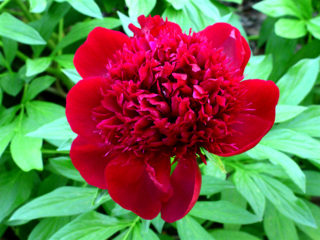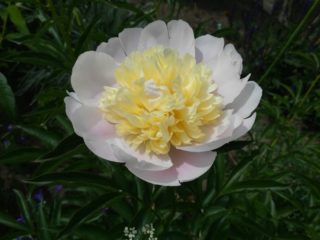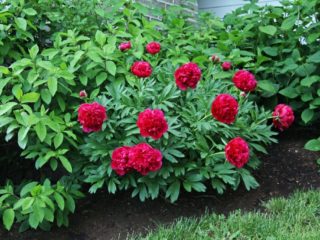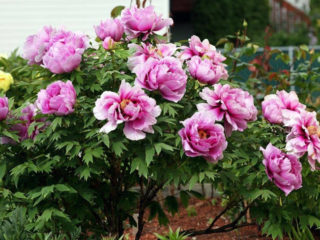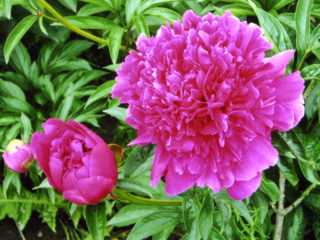Content
The Miss America peony has been delighting flower growers since 1936. It has repeatedly received awards from various flower growing societies. The culture is frost-resistant, unpretentious, and delights with long-lasting and luxurious flowering.
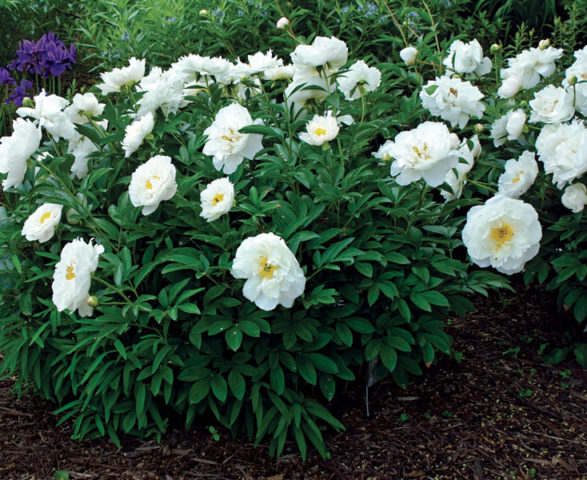
Airy flowers of Miss America are located on strong shoots that do not bend towards the soil
Description of the Miss America peony variety
The herbaceous milk-flowering peony of the Miss America variety has a compact bush with a semicircular crown, which is formed by erect, strong shoots. The diameter and height of the bush is 60-90 cm. A strong root system feeds strong shoots that branch weakly. The lower part of the stems is covered with leaves; a powerful peduncle rises upward. The dark green leaf blades are trifoliate, shiny on top. Thanks to the leaves, the Miss America peony bush retains its decorative value until the end of the warm season.
The variety is sun-loving, shows all its attractiveness only in an open area, and develops quickly if there is a sufficient amount of humus. Miss America is recommended for cultivation in all regions of the middle zone. The plants are frost-resistant; the rhizomes under a layer of mulch can withstand low temperatures down to -40 °C.
Features of flowering
Gardeners highly value the semi-double Miss America peony. The herbaceous large-flowered variety is characterized by lush and long-lasting flowering. The beauty of the peony comes from its wide snow-white petals and yellow-golden stamens, which enliven the center of the flower. Wide folded petals are arranged in two to four rows. Mid-early peony buds bloom at the end of May or in the first ten days of June. Flowering time depends on the geographical location of the site and weather conditions.
Each Miss America flower does not fall off for a long time, up to 7-10 days. The combination of bright white and yellow shades gives the peony variety airiness and elegance. The diameter of large flowers of an adult Miss America bush reaches 20-25 cm. During flowering, a light aroma is felt. Each peduncle bears at least three buds. Large flowers are formed on bushes:
- growing on fertile substrate;
- receiving sufficient moisture and fertilizing;
- correctly formed.
Peony buds are normalized at the beginning of development. 1-2 buds are left on the peduncle.
Application in design
The Miss America peony is an ideal element in many bouquet arrangements or a component of garden decoration. The bush is planted as a soloist in a flower bed or on a lawn, as well as in compositions with other peonies or flower bushes. Snow-white inflorescences look solemn against the background of coniferous crops. Great partners for Miss America are bright red peonies or varieties with wine-colored petals.If several peony plants are planted, they are placed in a checkerboard pattern.
To accompany Miss America, various low-growing flowers are selected, for example, primroses, heucheras, and violets. Carnations, irises, bells, and lilies are planted nearby. The main rule in combining plants with peonies is that near a luxurious bush, the soil of one and a half to two trunk diameters should be accessible for loosening and weeding. In such conditions, nothing prevents the rhizomes from developing.
Flower growers do not confirm the negative effect on roses attributed to peony. If the bushes are too close, less than 1 m, both plants will suffer from lack of ventilation.
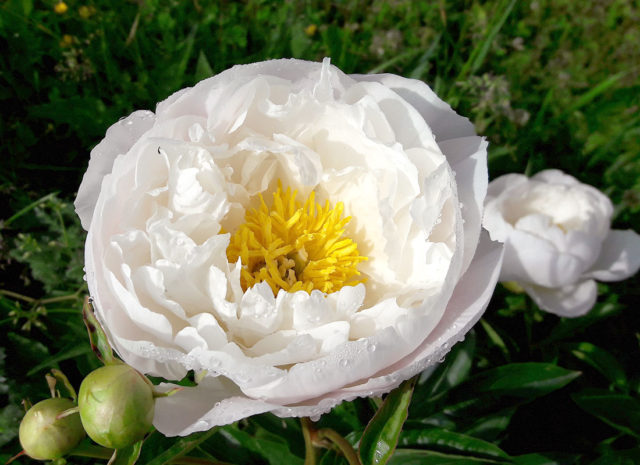
After blooming, the petals of the soft pink buds acquire a dazzling whiteness.
A medium-sized variety of herbaceous peony can be grown in 20-liter flowerpots on terraces. Specially bred low varieties of lush flowers are planted on balconies and loggias. Culture does not like transplants. It is recommended to place the rhizome immediately in a large container. Great attention is paid to tub culture:
- regular watering;
- feeding every 14-17 days;
- removal of excess shoots in the spring - leave no more than 5-7 shoots;
- carefully wrapping containers for the winter.
Reproduction methods
The Miss America herbaceous peony is most often propagated by dividing the rhizomes. This is the most effective way to get a new, healthy and strong plant. Experienced gardeners also root cuttings cut from stems in the summer, or propagate by divisions from spring shoots. The method of dropping layering from formed stems is also used.
The easiest way is to divide the mother bush of adult peonies in the fall, at least 5-6 years old.Such seedlings take root well and begin to bloom profusely in the second or third year.
Flower buds form on the rhizome in early August. At the end of September, thick white roots are fully formed, in which the plants store nutrients. In the interval between these important processes for the peony, it is easiest to divide the rhizomes and select new planting material.
Landing rules
Miss America peonies are best replanted in late summer or early autumn. Only as a last resort are peonies moved at the very beginning of spring. In the middle zone, divisions are planted from the second ten days of August to mid-September; planting in the southern regions continues until the end of the month. An important requirement for planting time is that the plant has time to take root before the soil freezes.
When choosing a site for peonies, follow these requirements:
- it is brightly lit by the sun;
- located 1 m from buildings, since constant ventilation is necessary to prevent diseases;
- land with neutral soil – pH 6-6.5.
The culture develops well on loams.
To plant the Miss America peony, they dig holes 50-60 cm deep and the same diameter. Drainage is placed down with a layer of 5-7 cm. The planting substrate consists of garden soil, humus or compost, and a glass of wood ash. The substrate is poured into the hole, the rhizome is placed, the soil is lightly compacted, sprinkled with the remaining soil and watered. It takes 2 years for the peony to develop, then the period of lush flowering of the bush begins. In one place, the peony blooms wildly for up to 20 years.
Aftercare
The Miss America large-flowered peony requires frequent watering, at least 1-2 per week.In the south, the frequency of watering together with evening sprinkling may increase, especially during periods of drought. Watering does not stop in August and September, since moisture in the ground is necessary for the constant development of the rhizome. The area where peonies grow must be kept in order, weeds are regularly removed and the soil is kept loose.
The Miss America variety is fed at least 3 times:
- in early spring;
- in the phase of growth and creation of buds;
- in the fall.
In the spring-summer period, nitrogen and potassium fertilizers are used, and in the fall, potassium-phosphorus fertilizers are necessary for the formation of flower buds and winter hardiness.

When choosing a seedling, the rhizome is examined; it should be without damage, with several buds
Preparing for winter
Faded buds are cut off so that the plant does not waste energy on producing seeds. But the shoots are left to grow along with the leaves until late autumn in order to ensure the normal process of photosynthesis and the development of replacement buds.
In late autumn, before frost, the stems of peonies are cut above ground level. Wood ash and bone meal are added to the tree trunk circle and covered with loose garden soil or mixed with compost. Peonies should not be covered with improvised materials. This can only be taken care of in regions with harsh climates, especially for young seedlings. Mature bushes are only covered with soil and compost or peat is placed on top.
Pests and diseases
To prevent the spread of fungal infections, gray rot and rust, in the fall old leaves along with stems are removed from the site. In spring, the bush is treated with new generation fungicides. During the growing season, the tree trunk circle is kept well-groomed and weeds are removed.For a densely leafy bush, good ventilation and sufficient distance from other crops are important.
Flowers are bothered by garden ants and bronze beetles, which, by sucking the juice from the buds, spoil the appearance of the petals. Beetles are collected mainly by hand, and ants are controlled using targeted drugs, since they can also carry diseases.
Conclusion
The Miss America peony is one of the most spectacular varieties. Proper placement in the flower bed, timely prevention and compliance with other agricultural technology requirements will allow you to enjoy long-lasting flowering and a pleasant aroma in the garden.


